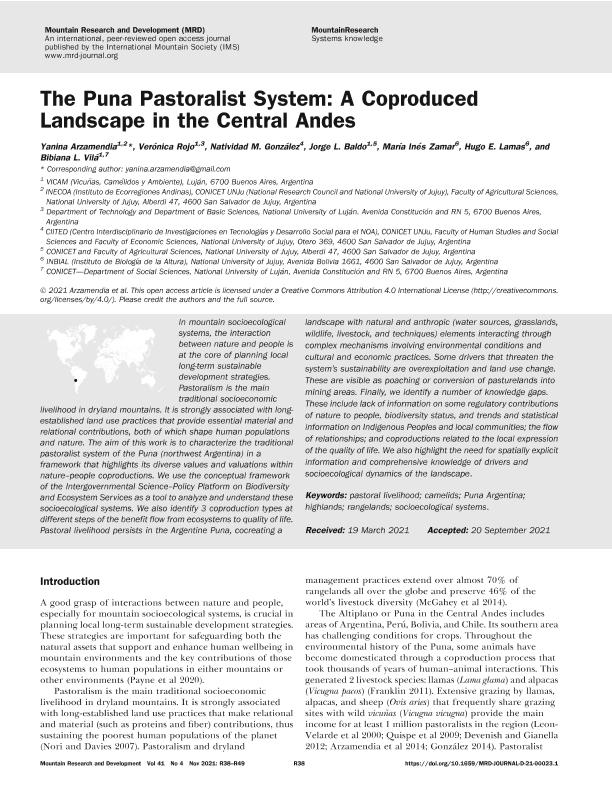Mostrar el registro sencillo del ítem
dc.contributor.author
Arzamendia, Yanina

dc.contributor.author
Rojo, Veronica

dc.contributor.author
González, Natividad María

dc.contributor.author
Baldo, Jorge Luis

dc.contributor.author
Zamar, María Inés

dc.contributor.author
Lamas, Hugo Eduardo

dc.contributor.author
Vila, Bibiana Leonor

dc.date.available
2022-05-17T02:58:11Z
dc.date.issued
2021-12
dc.identifier.citation
Arzamendia, Yanina; Rojo, Veronica; González, Natividad María; Baldo, Jorge Luis; Zamar, María Inés; et al.; The Puna Pastoralist System: A Coproduced Landscape in the Central Andes; Mountain Research & Development; Mountain Research And Development; 41; 4; 12-2021; 38-49
dc.identifier.issn
0276-4741
dc.identifier.uri
http://hdl.handle.net/11336/157711
dc.description.abstract
In mountain socioecological systems, the interaction between nature and people is at the core of planning local long-term sustainable development strategies. Pastoralism is the main traditional socioeconomic livelihood in dryland mountains. It is strongly associated with long-established land use practices that provide essential material and relational contributions, both of which shape human populations and nature. The aim of this work is to characterize the traditional pastoralist system of the Puna (northwest Argentina) in a framework that highlights its diverse values and valuations within nature?people coproductions. We use the conceptual framework of the Intergovernmental Science?Policy Platform on Biodiversity and Ecosystem Services as a tool to analyze and understand these socioecological systems. We also identify 3 coproduction types at different steps of the benefit flow from ecosystems to quality of life. Pastoral livelihood persists in the Argentine Puna, cocreating a landscape with natural and anthropic (water sources, grasslands, wildlife, livestock, and techniques) elements interacting through complex mechanisms involving environmental conditions and cultural and economic practices. Some drivers that threaten the system´s sustainability are overexploitation and land use change. These are visible as poaching or conversion of pasturelands into mining areas. Finally, we identify a number of knowledge gaps. These include lack of information on some regulatory contributions of nature to people, biodiversity status, and trends and statistical information on Indigenous Peoples and local communities; the flow of relationships; and coproductions related to the local expression of the quality of life. We also highlight the need for spatially explicit information and comprehensive knowledge of drivers and socioecological dynamics of the landscape.
dc.format
application/pdf
dc.language.iso
eng
dc.publisher
Mountain Research & Development

dc.rights
info:eu-repo/semantics/openAccess
dc.rights.uri
https://creativecommons.org/licenses/by-nc-sa/2.5/ar/
dc.subject
PASTORAL LIVELIHOOD
dc.subject
CAMELIDS
dc.subject
PUNA ARGENTINA
dc.subject
HIGHLANDS
dc.subject
RANGELANDS
dc.subject
SOCIOECOLOGICAL SYSTEMS
dc.subject.classification
Conservación de la Biodiversidad

dc.subject.classification
Ciencias Biológicas

dc.subject.classification
CIENCIAS NATURALES Y EXACTAS

dc.subject.classification
Ciencias Sociales Interdisciplinarias

dc.subject.classification
Otras Ciencias Sociales

dc.subject.classification
CIENCIAS SOCIALES

dc.subject.classification
Ganadería

dc.subject.classification
Producción Animal y Lechería

dc.subject.classification
CIENCIAS AGRÍCOLAS

dc.title
The Puna Pastoralist System: A Coproduced Landscape in the Central Andes
dc.type
info:eu-repo/semantics/article
dc.type
info:ar-repo/semantics/artículo
dc.type
info:eu-repo/semantics/publishedVersion
dc.date.updated
2022-05-06T16:10:22Z
dc.identifier.eissn
1994-7151
dc.journal.volume
41
dc.journal.number
4
dc.journal.pagination
38-49
dc.journal.pais
Suiza

dc.journal.ciudad
Bern
dc.description.fil
Fil: Arzamendia, Yanina. Universidad Nacional de Jujuy. Instituto de Ecorregiones Andinas. Consejo Nacional de Investigaciones Científicas y Técnicas. Centro Científico Tecnológico Conicet - Salta. Instituto de Ecorregiones Andinas; Argentina. Universidad Nacional de Jujuy. Facultad de Ciencias Agrarias; Argentina
dc.description.fil
Fil: Rojo, Veronica. Universidad Nacional de Luján; Argentina
dc.description.fil
Fil: González, Natividad María. Universidad Nacional de Jujuy. Facultad de Humanidades y Ciencias Sociales; Argentina. Universidad Nacional de Jujuy. Centro Interdisciplinario de Investigaciones en Tecnologías y Desarrollo Social para el Noa. - Consejo Nacional de Investigaciones Científicas y Técnicas. Centro Científico Tecnológico Conicet - Salta-Jujuy. Centro Interdisciplinario de Investigaciones en Tecnologías y Desarrollo Social para el Noa; Argentina
dc.description.fil
Fil: Baldo, Jorge Luis. (conicet/provincia de Jujuy); Argentina. Universidad Nacional de Jujuy. Facultad de Ciencias Agrarias; Argentina
dc.description.fil
Fil: Zamar, María Inés. Universidad Nacional de Jujuy. Instituto de Ecorregiones Andinas. Consejo Nacional de Investigaciones Científicas y Técnicas. Centro Científico Tecnológico Conicet - Salta. Instituto de Ecorregiones Andinas; Argentina. Universidad Nacional de Jujuy. Instituto de Biología de la Altura; Argentina
dc.description.fil
Fil: Lamas, Hugo Eduardo. Universidad Nacional de Jujuy. Instituto de Biología de la Altura; Argentina
dc.description.fil
Fil: Vila, Bibiana Leonor. Consejo Nacional de Investigaciones Científicas y Técnicas; Argentina. Universidad Nacional de Luján. Departamento de Ciencias Sociales; Argentina
dc.journal.title
Mountain Research And Development

dc.relation.alternativeid
info:eu-repo/semantics/altIdentifier/doi/http://dx.doi.org/10.1659/MRD-JOURNAL-D-21-00023.1
dc.relation.alternativeid
info:eu-repo/semantics/altIdentifier/url/https://bioone.org/journals/mountain-research-and-development/volume-41/issue-4/MRD-JOURNAL-D-21-00023.1/The-Puna-Pastoralist-System--A-Coproduced-Landscape-in-the/10.1659/MRD-JOURNAL-D-21-00023.1.full
Archivos asociados
